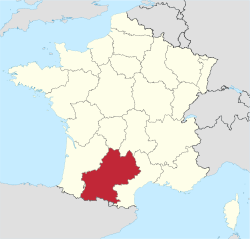Midi-Pyrenees
| Midi-Pyrénées | |||
|---|---|---|---|
| Region of France | |||
|
|||
 |
|||
| Country |
|
||
| Prefecture | Toulouse | ||
| Departments | |||
| Government | |||
| • President | Martin Malvy (PS) | ||
| Area | |||
| • Total | 45,348 km2 (17,509 sq mi) | ||
| Population (2012-01-01) | |||
| • Total | 2,926,592 | ||
| • Density | 65/km2 (170/sq mi) | ||
| Time zone | CET (UTC+1) | ||
| • Summer (DST) | CEST (UTC+2) | ||
| ISO 3166 code | FR-N | ||
| GDP (2012) | Ranked 8th | ||
| Total | €79.9 billion (US$102.7 bn) | ||
| Per capita | €27,198 (US$34,982) | ||
| NUTS Region | FR6 | ||
| Website | Midi-Pyrenees Region | ||
Midi-Pyrénées (French: [midi piʁene]; Occitan: Miègjorn-Pirenèus or Mieidia-Pirenèus; Spanish: Mediodía-Pirineos) is a former administrative region of France. Since 1 January 2016, it is part of the new region Occitanie. It was the largest region of Metropolitan France by area, larger than the Netherlands or Denmark.
Midi-Pyrénées has no historical or geographical unity. It is one of the regions of France created in the late 20th century to serve as a hinterland and zone of influence for its capital, Toulouse, one of a handful of so-called "balancing metropolises" (métropoles d'équilibre). Another example of this is the region of Rhône-Alpes which was created as the region for Lyon.
The name chosen for the new region was decided by the French government without reference to the historical provinces (too many of them inside the region). The name was based on geography, Midi (i.e. "southern France") - Pyrénées (Pyrenees mountains that serve as the region's southern boundary), although the region also includes the southernmost part of the Massif Central, which has better communications with Languedoc-Roussillon than with Toulouse. The French adjective and name of the inhabitants of the region is: Midi-Pyrénéen.
Historically, Midi-Pyrénées is made up of several former French provinces:
The historical makeup of Midi-Pyrénées is even more complex, as the provinces listed here are further subdivided into pays–used interchangeably in French for country, area, land, etc.–each with its own particular identity, such as Armagnac, Astarac, or Lomagne inside the Gascogne part of Midi-Pyrénées, Lauragais or Volvestre inside the Languedoc part of Midi-Pyrénées, Bonezan inside County of Foix, Lavedan inside Bigorre, and so on.
...
Wikipedia


